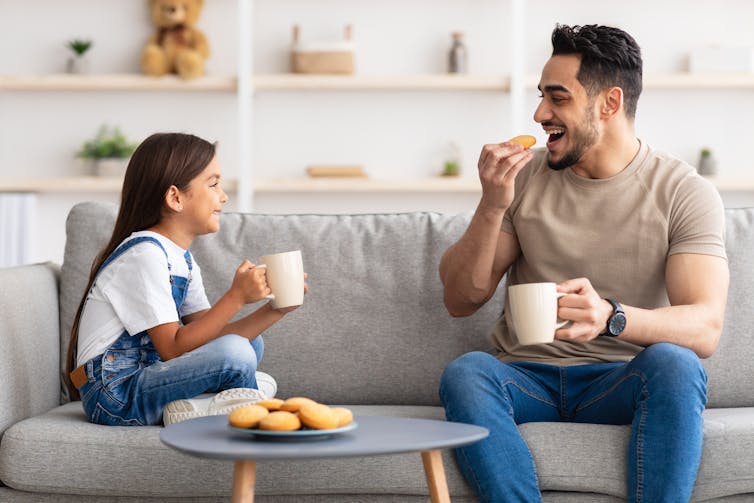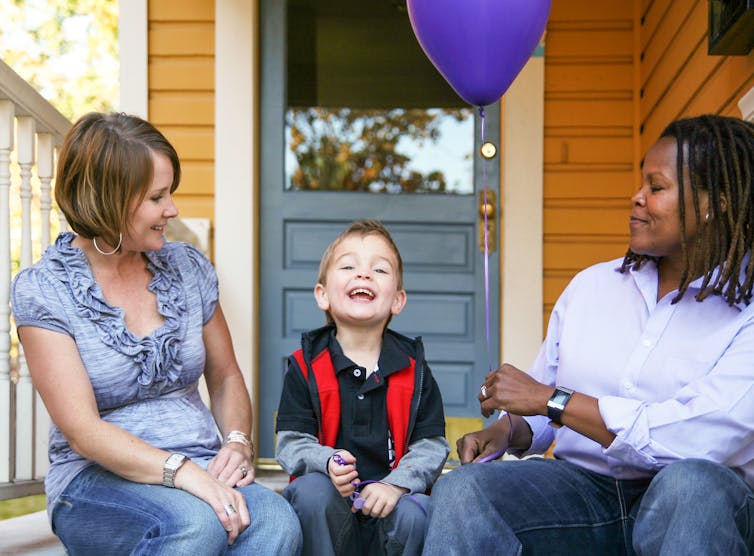Parents and caregivers of school-aged children are all too familiar with the after-school conversation that sounds a little something like:
“How was school?”
“Fine.”
“What did you learn?”
“Nothing.”
Conversations between children of all ages and attentive, caring adults offer strong benefits in all domains of children’s well-being.
When these conversations are purposeful and strategic, they can even strengthen skills that contribute to stronger literacy and language development.
More than information exchange
When we engage in quality conversations with children, we are doing more than finding out how their day was at school.
Talking with children teaches them about their world, enhances their vocabulary, strengthens trust and relationships and models formal language structures — how an arrangement and order of words in the context of specific sentences yields meaning.

The power of conversations between children and adults even has the potential to affect connectivity in select regions of the brain.
In a recent study in the Journal of Neuroscience, conversational “turns” — where there is a back-and-forth conversational exchange between children and attentive adults — were linked to increased strength of white matter connections between regions of the brain related to speech and comprehension of written and spoken language.
Sparking language-building conversations
The list below details some ways parents or caregivers can spark language-building conversations that accelerate children’s literacy and family relationships:
Actively listen. Active listening involves showing an authentic interest in what children have to say. Active listening looks like minimizing distractions, making eye contact, stopping other things you are doing, lowering yourself to their physical level (by sitting or bending down, for instance) and reflecting or repeating back what they are saying and what they may be feeling to make sure you understand.
Ask open-ended questions. Open-ended questions encourage children to pause, think and reflect instead of simply responding “yes” or “no” or “nothing.” Open-ended questions typically begin with the following words and phrases:
- Why, how, describe …
- Tell me about …
- What do you think about …
- I wonder (if / why / how) …
- What do you notice about …
- Tell me more about …
- What else do you want me to know about that?
Open-ended questions can also be used as follow-ups to other questions.

Try the “Strive-for-Five” framework. “Strive-for-Five” is a conversational framework pioneered by educators David Dickinson and Ann B. Morse and recently adapted by educational researchers Sonia Q. Cabell and Tricia A. Zucker. This framework is intended to enhance conversations by encouraging parents, caregivers and educators to strive for five conversational turns with children instead of the typical three in order to foster foundational language skill development. To try this, respond to children in a way that challenges their thinking and encourages using language. Rather than stopping short at the third conversational point, attempt to continue the conversation by asking fun, open-ended follow-up questions or share another thought to try to extend the exchange.
Embed conversations in everyday routines. If you find it difficult to actively listen and engage in purposeful conversations during certain times of the day, try to schedule time where active listening may be more feasible, like during everyday routines or when reading aloud.
Scaffold the conversation. Scaffolding is a strategy used to support learning by building on skills children already have and gradually reducing the support provided. Scaffolding conversations with children might include:
- repeating words or phrases so they are used correctly;
- integrating vocabulary from topics they are learning about or are curious about;
- providing sentence starters that invite them to finish the sentence;
- asking questions that challenge their thinking to move a conversation past the third talking turn.
Engaging in frequent, meaningful conversations with children of all ages helps strengthen their language comprehension, and in turn, reading comprehension.
Elevating the quality of conversations by using any or all of these suggestions has the potential to enhance the fundamental components of language comprehension, while simultaneously building and maintaining family connections.

